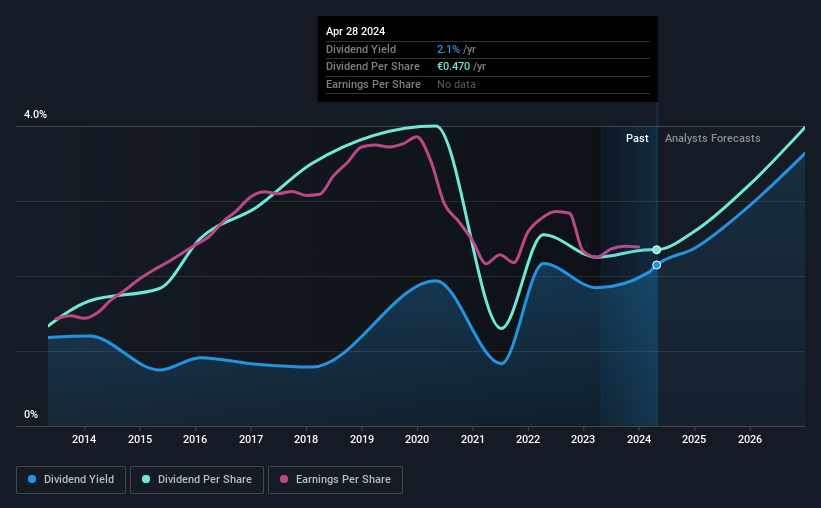Should Income Investors Look At Grenke AG (ETR:GLJ) Before Its Ex-Dividend?
It looks like Grenke AG (ETR:GLJ) is about to go ex-dividend in the next three days. The ex-dividend date occurs one day before the record date which is the day on which shareholders need to be on the company's books in order to receive a dividend. The ex-dividend date is important because any transaction on a stock needs to have been settled before the record date in order to be eligible for a dividend. Accordingly, Grenke investors that purchase the stock on or after the 2nd of May will not receive the dividend, which will be paid on the 6th of May.
The company's next dividend payment will be €0.47 per share, and in the last 12 months, the company paid a total of €0.47 per share. Based on the last year's worth of payments, Grenke stock has a trailing yield of around 2.1% on the current share price of €21.90. If you buy this business for its dividend, you should have an idea of whether Grenke's dividend is reliable and sustainable. We need to see whether the dividend is covered by earnings and if it's growing.
See our latest analysis for Grenke
Dividends are typically paid out of company income, so if a company pays out more than it earned, its dividend is usually at a higher risk of being cut. Grenke paid out a comfortable 26% of its profit last year.
Companies that pay out less in dividends than they earn in profits generally have more sustainable dividends. The lower the payout ratio, the more wiggle room the business has before it could be forced to cut the dividend.
Click here to see the company's payout ratio, plus analyst estimates of its future dividends.
Have Earnings And Dividends Been Growing?
Companies with falling earnings are riskier for dividend shareholders. If earnings fall far enough, the company could be forced to cut its dividend. Readers will understand then, why we're concerned to see Grenke's earnings per share have dropped 8.3% a year over the past five years. When earnings per share fall, the maximum amount of dividends that can be paid also falls.
Another key way to measure a company's dividend prospects is by measuring its historical rate of dividend growth. In the past 10 years, Grenke has increased its dividend at approximately 5.8% a year on average.
Final Takeaway
From a dividend perspective, should investors buy or avoid Grenke? Earnings per share have shrunk noticeably in recent years, although we like that the company has a low payout ratio. This could suggest a cut to the dividend may not be a major risk in the near future. It doesn't appear an outstanding opportunity, but could be worth a closer look.
If you're not too concerned about Grenke's ability to pay dividends, you should still be mindful of some of the other risks that this business faces. For example, we've found 2 warning signs for Grenke (1 is concerning!) that deserve your attention before investing in the shares.
If you're in the market for strong dividend payers, we recommend checking our selection of top dividend stocks.
Have feedback on this article? Concerned about the content? Get in touch with us directly. Alternatively, email editorial-team (at) simplywallst.com.
This article by Simply Wall St is general in nature. We provide commentary based on historical data and analyst forecasts only using an unbiased methodology and our articles are not intended to be financial advice. It does not constitute a recommendation to buy or sell any stock, and does not take account of your objectives, or your financial situation. We aim to bring you long-term focused analysis driven by fundamental data. Note that our analysis may not factor in the latest price-sensitive company announcements or qualitative material. Simply Wall St has no position in any stocks mentioned.

 Yahoo Finance
Yahoo Finance 
